If your fall to-do list includes raking up all the leaves in your yard and lugging them to the curb, cross this one off, and replace it with a football game, hike, or other fall activity. Then give yourself a pat on the back. By leaving the leaves, you’re improving your part of Pennsylvania’s environment.
Leave Some Leaves: Your Yard Will Love You for It
Decomposed leaves are free natural nutrients that will strengthen your soil, grass, and gardens. In fact, "the leaves of one large shade tree can be worth as much as $50 of plant food and humus,"
according to Penn State Extension.
Leaf litter also provides much needed winter habitat and forage sources for birds, insects, amphibians, and other small wildlife that are part of the ecosystem we depend on. Did you know some bees, moths, and butterflies can live under thick leaf cover throughout the winter?
Fallen leaves also absorb rain and release moisture back into soil and plants as they decompose. Not only does this improve the health of the vegetation in your yard, but it's a great way to
be stormwater smart and help reduce runoff pollution in Pennsylvania's local streams and rivers.

University of Delaware Professor
Doug Tallamy, author of the bestselling Bringing Nature Home, has increased awareness across the country of the importance of protecting the natural resources in your own backyard—and ways to do it. Get more good tips from the
National Audubon Society,
National Wildlife Federation,
Habitat Network, and other organizations.
Another great reason to leave some leaves in your yard: It keeps them out of landfills. The
U.S. Environmental Protection Agency calculated that, in 2018, landfills received about 10.5 million tons of yard trimmings, including leaves. This was about 7.2 percent of all municipal solid waste that was landfilled.
Lastly, a more natural yard offers a rustic beauty and wildlife activity to watch and enjoy all winter long.
How to Get Started
If you don't want to go all in right off the bat, start by keeping SOME leaves. Rake the area with the heaviest, wettest layer of leaves. Or rake the front yard but not the back. Or rake once, before the trees have dropped all their leaves; when the rest of the leaves fall, let them stay as a light layer over your yard.
Place raked-up leaves in a loose compost pile in a corner of the yard or in a compost bin. Adding grass clippings will add nitrogen. In the spring, you'll have compost to fertilize your gardens.
Penn State Extension offers good instructions.
You can also mulch-mow, chopping the leaves and leaving them on the ground to nourish the grass and soil. Most newer mowers have a mulch blade, but older mowers should work too.
Pennsylvanians Leading the Way on Leaves
A few master gardeners and master watershed stewards from Penn State Extension have more suggestions.

Diane and Fred Oleson leave their leaves in strategic spots. "Our tactic is to have our trees in beds, so we create no-rake forest floors. We don't want to waste nutrients that we can recycle," says Diane.
Bird watcher Shawnna Lockwood leaves the leaves around her blueberry bushes and brush pile. She says, “The leaves attract a lot of native birds that stay all winter long. They flip the leaves over to look for insect snacks.”

Wendy and Scott Siefert have transitioned over the past few years to a completely naturalized, no-mow yard. This includes leaving the leaves.
“We leave our leaves so they can decompose and become a component of rich, healthy soil,” Wendy says. “We don't have to bag them in plastic trash bags and drag them to the curb. Instead we provide habitat and shelter for wildlife all year long. This year, I watched an adult robin showing a fledgling how to root in the leaves for food.”
“We leave our leaves to leave a better planet for our children,” she adds.
